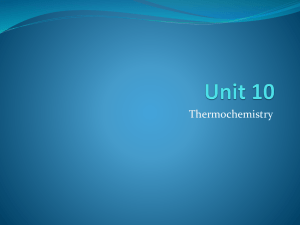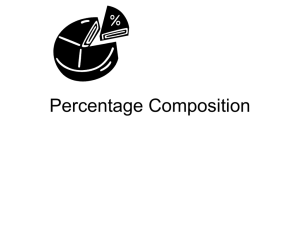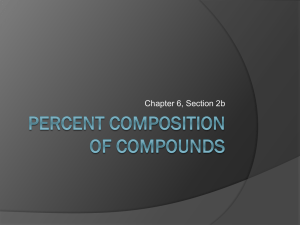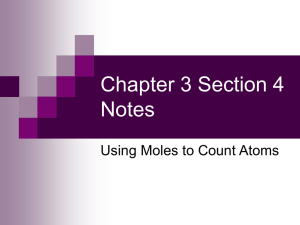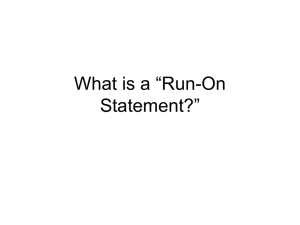Unit 3 Review Jeopardy
advertisement
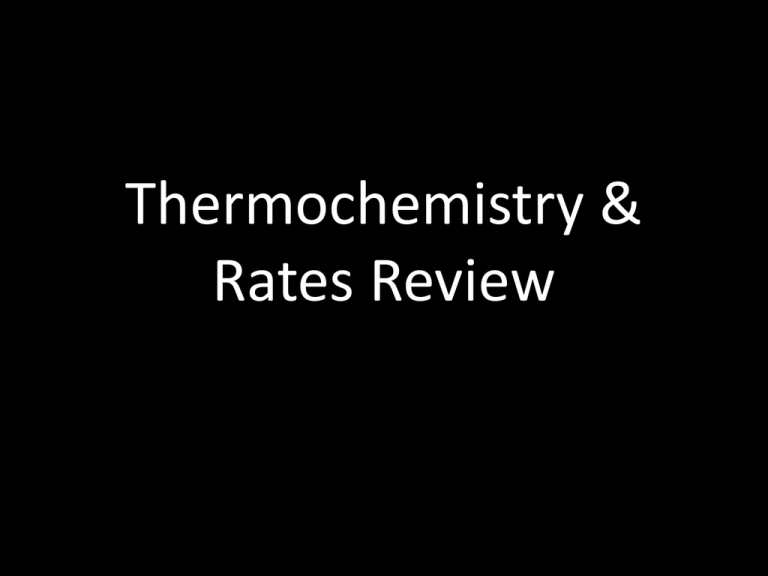
Thermochemistry & Rates Review TITLE A 100 TITLE B TITLE C TITLE D TITLE D Thermochemistry & Rates 100 100 100 100 200 200 200 200 200 300 300 300 300 300 400 400 400 400 400 500 500 500 500 500 The units for enthalpy change are: a. kJ c. kJ/mol b. kJ/kg•°C d. kJ/L•°C 1A Answer 100 a. kJ Q2A Question 200 What is the unit of rate constant, K, if it is a second- order reaction and the rate is measured in mol/L.s and concentrations in mol/L 2A ANSWER 200 K= L/mol Q3A Question 300 In the reaction: CH4 +2O2 CO2 + 2H2O The rate of consumption of oxygen gas is observed to be 4 mol/(L.min). What is the rate of production of CO2 gas? a)1 mol/(L.min) b) 2 mol/(L.min) c) 4 mol/(L.min) d) 8 mol/(L.min) 3A ANSWER 300 b) 2 mol/(L.min) Q4A Question 400 The rate of reaction depends upon: a)The concentration and nature of the reactant b)The temperature of the reaction c)Whether or not a catalyst was used d)All of the above 4A Answer 400 d)All of the above Q5A Question 500 Which of the following factors that affect rate of reaction applies only to heterogenous system a) Surface area b) Concentration c) Temperature d) catalyst 5A Answer 500 a)Surface area Q1B Question 100 The catalytic converter on a vehicle is: a) A biological catalyst b) Heterogenous catalyst c) A homozygous catalyst d) A reactant 1B Answers 100 a) Heterogenous catalyst Q2B Question 200 The activation energy of a chemical reaction is affected by: a) The kinetic energy of the reactant b) The potential energy of the product c) The presence of a catalyst d) None of the above 2B Answer 200 a) The presence of a catalyst Q3B Question 300 If the initial rate of reaction is observed to increase by a factor of 9 when the concentration of a reactant is tripled, what is the order of reaction with respect to the reactant a) 0 b) 1 c) 2 d) 3 3B Answer 300 c) 2 Q4B Question 400 The gas phase reaction A + B C has a reaction rate that is experimentally observed to follow the relationship: rate = K[A]2. What is the reaction order with respect to B a) 0 b) 1 c) 2 d) 3 4B Answer 400 a) 0 Q5B Question 500 Which of the following statement is incorrect? a) The reaction rate for a zero-order reaction is independent of the concentration b) The rate constant for a second-order reaction is dependent on temperature c) The rate law expression relates rate and concentration d) The rate constant for a first-order reaction never varies with temperature or pressure 5B Answer 500 d) The rate constant for a first-order reaction never varies with temperature or pressure Q1C Question 100 • Which of the following corresponds to the equation for the standard molar enthalpy of formation of solid sodium chlorate, NaClO3 a.Na(s) + 1/2 Cl2(g) + 3/2O2 → NaClO3(s) b. 2Na(s) + Cl2(g) +3O2(g) →2NaClO3(s) c. Na(s) + Cl(g) + 3O(g) → NaClO3(s) d. NaCl(s) + 3/2 O2(g) → NaClO3(s) 1C Answer 100 a. Na(s) + 1/2 Cl2(g) + 3/2O2 → NaClO3(s) Q2C Question 200 Which of these describes a reaction intermidiates a) Starting material b) A product c) Something formed and consumed during a reaction d) A step in a reaction mechanism 2C Answer 200 c) Something formed and consumed during a reaction Q3C Question 300 How many Kilojoules of heat is necessary to decompose 90 g of H2O(g) into H2(g) and O2(g) at ambient temperature and pressure H2(g) + O2(g) → H2O (g) a)48.1 kJ b)120.9 kJ c)241.8 kJ d)1208 kJ ∆Hof = -241.8KJ 3C Answer 300 d) 1208 kJ Q4C Question 400 In a coffee-cup calorimeter, 50 ml of 1.0 mol/L HCl was neutralized by 50 ml of 1.0 mol/L NaOH. Initial temperature of both solutions were 24.5oC. Final temperature after the reaction was 75.5oC. 1. 2. 3. 4. 5. 6. Was the reaction exothermic or endothermic? Explain Calculate the mass of both solutions Calculate the temperature change Determine the thermal energy, q, released by the reaction. Calculate the number of moles of base in the reaction Calculate the molar enthalpy of neutralization, ∆Hneut. Of the base. 4C Answer 400 1. Exothermic reaction. Increase in temperature of the surrounding 2. 50 gm each 3. 75.5 oC– 24.5oC = 51oC 4. q =mc∆t =100g x4.18J/g.oC x51oC = - 21.32kJ 5. n = C xV(L) =1.0mol/L x 50 ml/1000ml = 0.05 mol 6. q = ∆H = n∆Hneut; q = n∆Hneut ∆Hneut = q/n = - 21.32kJ 0.05 mol - 426.4 kJ/mol Q5C Question 500 . In a coffee cup calorimeter, you place 15.0 mL of distilled water and measure the starting temperature to be 25C. You then place 2.44 g of an unknown metal (initially heated up to 99.8C) into the distilled water and insulate the calorimeter. After equilibrium, the final temperature of the water and the unknown metal is 26.1C. What is the specific heat (in J/gC) of the unknown metal? The specific heat of water is 4.184 J/gC. Assume that no heat is transferred to the calorimeter. Show your starting equations, all of your calculations, and box in your final answer. • • • • • • • • • • • • • • • • mw =15 ml x1 g/ml =15 g water t1w = 25 oC t2w = 26.1 ∆t w = t2 – t1 = 26.1oC – 25oC =1.1 o C cw = 4.18J/g x oC qw =mc∆t = 15 g x 4.18J x1.1oC g x oC = 68.97 J m unknown m = 2.44 g t1metal = 99.8 oC t2 metal = 26.1oC ∆t metal = 26.1oC – 99.8 oC -qmetal = qwater (2.44 g x c x -73.7 oC) =68.97 J c = 68.97 J 179.828 gxoC 0.3835 J/g.oC Q1D Question 100 For the reaction: A + 2B → 3C When the rate of appearance of C is 9 x 10-7 mol/L.s, What will be the rate of disappearance of B? a) 2 x 10-7mol/L.s b) 12 x 10-7 mol/L.s c) 6 x 10-7 mol/L.s d) 9 x 10-7 mol/L.s 1D Answer 100 c) 6 x 10-7 mol/L.s Q2D Question 200 In a reaction mechanism, the rate determining step is always: a) The last step b) The slowest step c) The reaction intermediate d) The fastest step 2D Answer 200 b) The slowest step Q3D Question 300 True or false The instantaneous reaction rate is always constant. 3D Answer 300 False Q4D Question 400 Pyruvic acid is a molecule involved as an intermediate in metabolic reactions such as cellular respiration. Pyruvic acid (CH3COCOOH) is converted into acetic acid and carbon monoxide in the reaction: CH3COCOOH CH3COOH + CO If the molar enthalpies of combustion of these substances are, respectively –1275 kJ/mol, -875 kJ/mol, and -282.7 kJ/mol, use Hess’s law to calculate the enthalpy change for the given reaction. [Hint: write equations to represent the combustion reactions for the reactant and products. The given reaction above is the target equation] 1. CH3COCOOH + 5O2 → 3CO2 + 2H2O ∆HCom = –1275 kJ -1 x 2. CH3COOH + 2O2 → 2CO2 + 2H2O ∆HCom = 875 kJ x-1 -1 x 3. CO + 1/2O2 → CO2 ∆HCom = 282.7 kJ x-1 1. CH3COCOOH + 5/2O2 → 3CO2 + 2H2O ∆HCom1 = –1275 kJ 2. 2CO2 + 2H2O → CH3COOH + 2O2 ∆HCom2 = 875 kJ 3. CO2 → CO + 1/2O2 ∆HCom3 = 282.7 kJ Cancel molecules common to both sides Sum up the molecules and enthalpy change of three reactions: ∆H =∆H Com1 + ∆HCom2 + ∆HCom2 CH3COCOOH CH3COOH + CO ∆Hr = 117.3 KJ Q5D Question 500 A certain chemical reaction can be represented by the following equation. 2A(g) + B(g) → C(g) At a fixed temperature, the initial rate of the reaction was measured for various initial concentrations of A and B. The results were as follows: Initial Conc. (mol/L) Initial reaction Rate (mol/L.s) A B 0.5 0.5 2.0 x 10-3 1.0 0.5 8.0 x 10-3 1.0 1.0 8.0 x 10-3 1.5 1.0 18 x10-3 1.0 1.5 8.0 x 10-3 • The rate law expression for this reaction is a) Rate = K[A][B] b) Rate = K[B]2 c) Rate = K[A]2[B]2 d) Rate = K[A]2 5D Answer 500 d) Rate = 2 K[A] Q1E Question 100 Similar elements tend to react similarly, but at different reaction rate. 1E Answer 100 True Q2E Question 200 The heat released during the combustion of C3H8(g) (propane) to produce CO2(carbon dioxide) gas and water vapour is 2222 kJ/mol of C3H8(g). Which of the following is the correct chemical equation for the reaction? a. C3H8(g) + 5O2(g) → 3CO2(g) + 4H2O (g) ∆H = +2222 kJ b. C3H8(g) + 5O2(g) + 2222 kJ → 4H2O (g) + 3CO2(g) c. C3H8(g)+ 5O2(g) →3CO2(g) + 4H2O (g) + 2222 kJ d. 3CO2(g) + 4H2O(g) → 5O2(g) + C3H8(g) = ∆H 2222 kJ 2E Answer 200 c. C3H8(g)+ 5O2(g) →3CO2(g) + 4H2O (g) + 2222 kJ Q3E Question 300 According to the Rate Law, the rate (r) for the reaction aX +bY → product must be proportional to: a. [X] c. [X]a[Y]b b. [Y] d. [X]m[Y]n 3E Answer 300 d. m n [X] [Y] Q4E Question 400 Consider the decomposition of hydrogen peroxide reaction. If the rate of decomposition of hydrogen peroxide at a particular temperature is determined to be 0.098 mol/(L·s), what are the rates of reaction with respect to the products of the decomposition reaction? [Hint: Be sure to write a balanced chemical equation to represent the reaction] 4E Answer 400 H2O2(l) → H2(g) + O2(g) ∆[H2O2(l)] = 0.098 mol/(L.s) ∆t ∆[H2O2(l)] = [H2(g)] ∆t ∆t = [O2(g)] ∆t [H2(g)] = 0.098 mol/L.s ∆t [O2(g)] = 0.098 mol/L.s ∆t Q5E Question 500 Insert Daily double question or picture here. 5E Answer 500 Insert answer or picture choice here!




